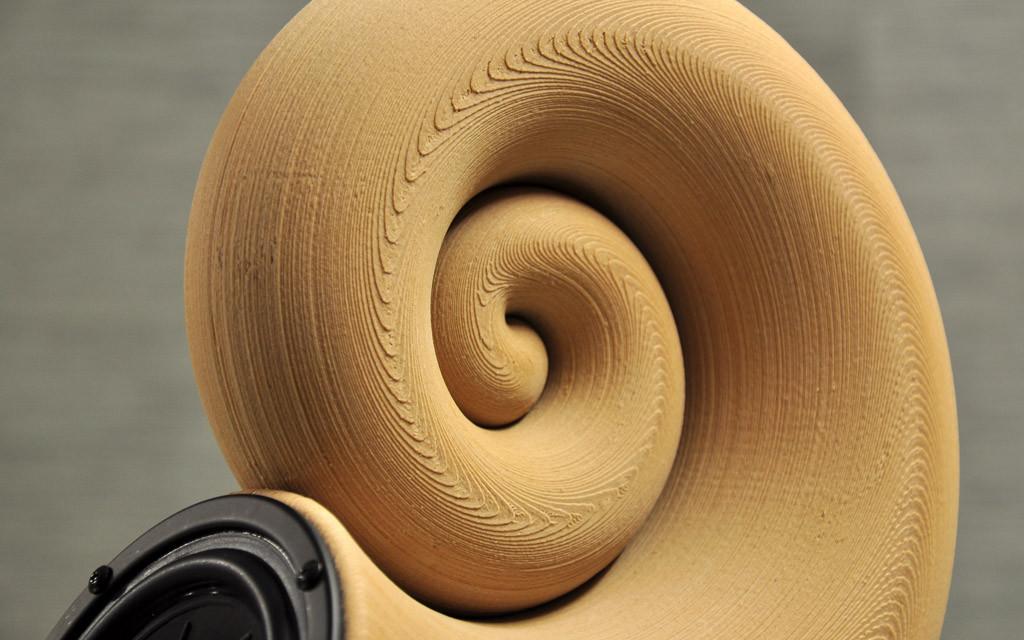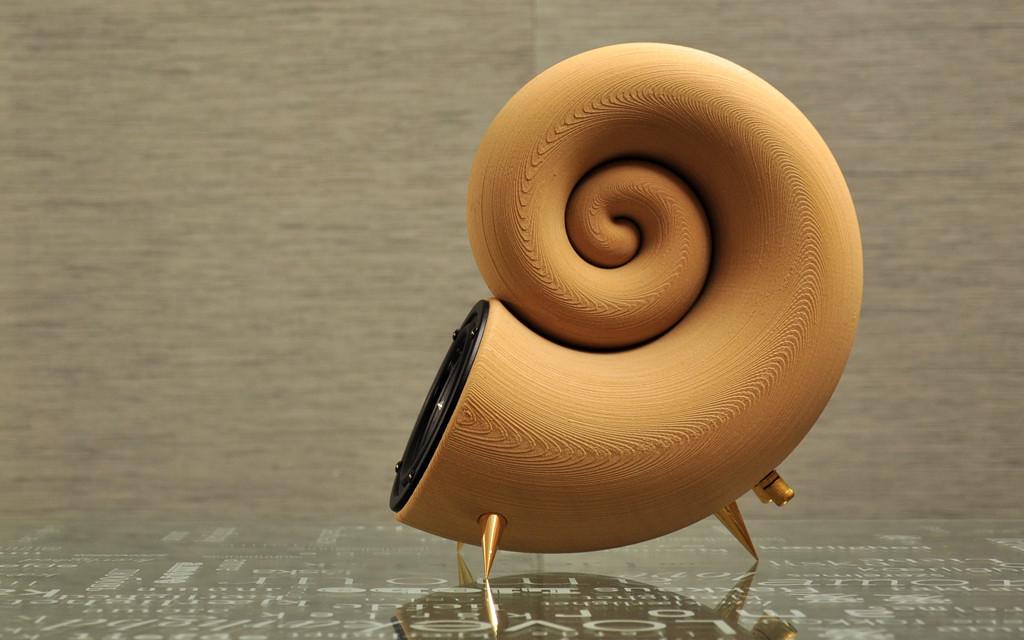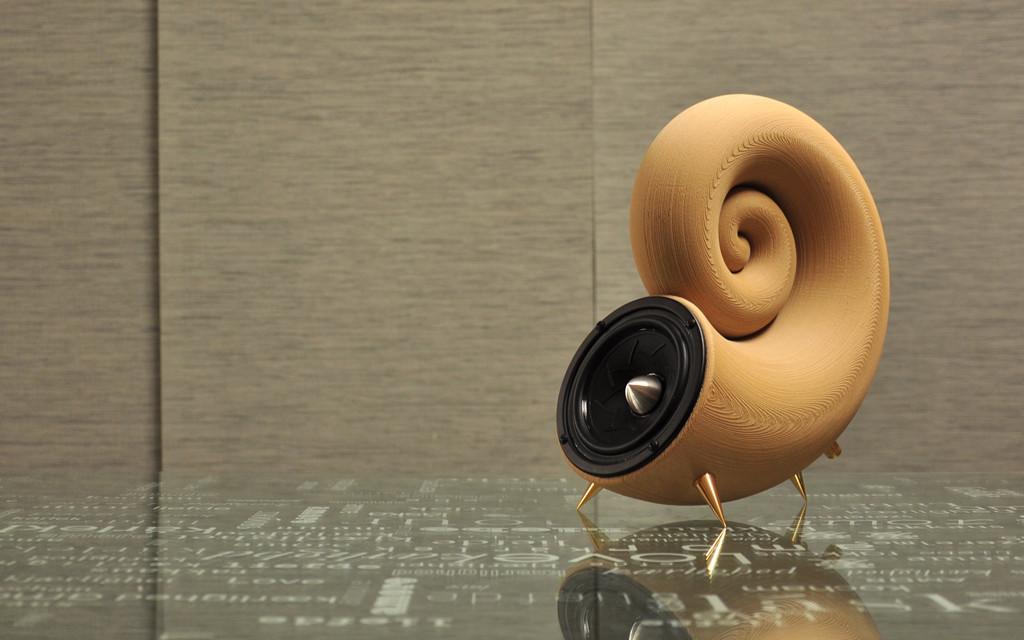 When most people think about FDM 3D printers, they picture these machines printing in PLA or ABS plastic. Recently, more and more people have begun using other materials like nylon. However, a company called Akemake, with the help of a new 3D printing material from Fillamentum, is trying to change this.
When most people think about FDM 3D printers, they picture these machines printing in PLA or ABS plastic. Recently, more and more people have begun using other materials like nylon. However, a company called Akemake, with the help of a new 3D printing material from Fillamentum, is trying to change this.
Akemake has recently used a 100% natural wood filament called Timberfill to print out a working desktop speaker.
“This 3D printed model is the first speaker in the world printed from Timberfill material made by Fillamentum,” Machal Kandler of Akemake tells 3DPrint.com. “Yes, it is 100% wood!”
The speaker, called the Spirulida, was designed by Ondra Chotovinsky, and is based on a deep sea squid-like species – the Spirulida. Akemake is offering this design completely free for those who wish to print it out at home. They also provide the instructions for assembling it.
The Timberfill filament, used in printing this speaker, not only looks like wood, but the company says it behaves just like wood as well. As many of you know, wood is commonly used in the building of speakers, due to its physical characteristics of improving sound quality. Fillamentum offers a wide range of other 3D printing materials, with a large variety of materials, ranging from the Timberfill, to traditional PLA, ABS, and even PVA.
The specifications of the speakers are as follows (if you follow their assembly instructions):
- Driver Units: 4″ Full Range Speaker
- Nominal Impedance: 4Ω
- Nominal Power: 15W
- Overall Dimensions: 238 x 264 x 124 [mm]
- Printing Dimensions: 224 x 242 x 62 [mm]
- Shell Thickness: 6.0mm
- Internal Volume: 2.2l
Ondra Chotvinsky, the designer of this speaker informed 3DPrint.com that it takes approximately 18 hours to print one speaker. Each half is printed at a time (9 hours per half), without any support material, to achieve the highest possible quality of the exposed surface. After printing, it takes about another 2 hours to assemble the speaker. This includes bonding, some soldering and assembling the components.
“The weight of one speaker (without components) is roughly 650g, so it can printed out from one Timberfill roll,” explained Chotovincky. “The printing cost is approximately $52”
As for the total costs to print out and build one? It would cost approximately $120. Here is the breakdown:
• Spirula Speaker from Timberfill – 52$ (USD)
• Driver – W4-1052SDF – $40 (USD)
• Spikes – SPS35/SC – $22 (USD) per 4pcs
• RCA connectors – $7 (USD) per pair
You can visit Akemake and see the Spirula speakers exhibited at the Design Terminal in Budapest (5-7 June www.designterminal.com), 3D Printshow in London (4-6 Sept, 3dprintshow.com) and TCT show in Birmingham (30 Sept – 2 Oct www.tctshow.com).
We have seen wood-based filaments in the past, but haven’t seen anything that could almost replicate wood identically. I must admit that I have not had a chance to touch or feel this in person, and I’m a bit intrigued by the fact that Akemake claims that this is 100% wood. I would imagine there has to be some sort of bonding agent in the filament, which is not derived from wood. Are you going to give this design a try, and build it yourself at home? If so, be sure to let us know how it goes in the Akemake speaker thread on 3DPB.com
Subscribe to Our Email Newsletter
Stay up-to-date on all the latest news from the 3D printing industry and receive information and offers from third party vendors.
Print Services
Upload your 3D Models and get them printed quickly and efficiently.
You May Also Like
The Business Case for Binder Jet in an Uncertain World: Jedi Mind Tricks, Part I
You’ve probably noticed that the binder jet market has been rather rocky as of late. Voxeljet was delisted, was not sold, and is now restructuring. Nano Dimension subsidiary Desktop Metal...
Headmade Uses the Formlabs Fuse1+ to 3D Print Titanium
Headmade lets you take polymer laser powder bed fusion (LPBF) 3D printers and use them to print metal parts. Using what they call Cold Metal Fusion, a metal-doped polymer feedstock...
Reborn to Reshore: Why the Velo3D Story May Just Be Getting Started
As someone who was born in 1988, I’ve lived through some pretty wacky economic disruptions. But I think that the mood now prevailing in the global business environment may make...
INNOSPACE Is Using Eplus3D Metal Printers to Speed Up Space Launches
INNOSPACE, a space company from South Korea, is now using metal 3D printing to make rocket parts faster, cheaper, and more efficiently, entirely in-house for the first time. After purchasing...































